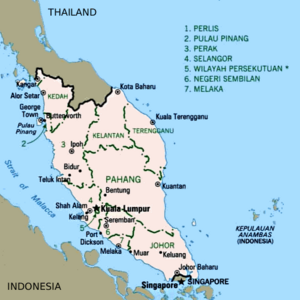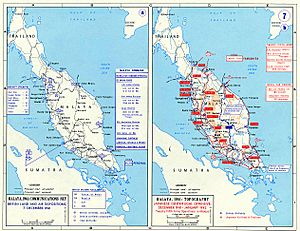Battle of Jitra facts for kids
Quick facts for kids Battle of Jitra |
|||||||
|---|---|---|---|---|---|---|---|
| Part of the Battle of Malaya, World War II | |||||||
 Map of the Malayan Peninsula. Jitra is situated in the state of Kedah (top left). |
|||||||
|
|||||||
| Belligerents | |||||||
| Commanders and leaders | |||||||
| Units involved | |||||||
| Casualties and losses | |||||||
| 26+ killed 350+ killed |
6 tanks destroyed 1+ tank damaged 27 killed 83 wounded |
||||||
The Battle of Jitra was a major fight during World War II in Malaya (now part of Malaysia). It happened from December 11 to 13, 1941. This battle was between the invading Japanese army and the Allied forces, which included British and Indian soldiers. The Japanese won, forcing the Allied commander, Arthur Percival, to move all Allied planes to Singapore.
Preparing for Battle: Jitra's Defenses
When the war in the Pacific began, the Allied defenses at Jitra were not ready. Soldiers had put up barbed wire and laid some anti-tank mines. However, heavy rains had filled the trenches and gun pits with water. Many field telephone cables also stopped working, which meant soldiers couldn't talk to each other easily during the battle.
Allied Forces at Jitra
Major General David Murray-Lyon led the Indian 11th Infantry Division. Two of his brigades were on the front line. The 15th Indian Infantry Brigade was on the right, and the 6th Indian Infantry Brigade was on the left. They had support from artillery units. A third group, the 28th Indian Infantry Brigade, made up of Gurkha soldiers, was kept in reserve.
The British front line was about 14 kilometers (9 miles) long. It stretched across roads, a railway, and through different types of land. This included hills, flooded rice fields, rubber tree estates, and even a mangrove swamp.
Before the battle, the Allies had a plan called "Operation Matador" to attack into Thailand. This plan was canceled. Instead, the 11th Indian Division moved back to defend Jitra. The defenses were still not good by December 8, 1941. General Murray-Lyon needed more time to get them ready. So, the British command came up with smaller plans to slow down the Japanese. These included "Krohcol," "Laycol," and an armored train. These small forces tried to keep the Japanese away from Jitra for as long as possible.
First Clashes: Delaying the Japanese
December 9: Japanese Advance
After the Japanese landed in Thailand on December 8, 1941, they began moving towards north-west Malaya. To slow them down, the British sent out two groups ahead of the 11th Indian Division.
One group was an armored train with soldiers from the 2/16th Punjab Regiment. They went to Perlis, blew up a railway bridge, and then returned to Malaya.
The second group was called Laycol. It had about 200 soldiers from the 1/8th Punjab Regiment, led by Major Eric Robert Andrews. They also had two anti-tank guns and engineers. Laycol moved about 10 kilometers (6 miles) into Thailand. Around 9:00 PM on December 9, the first Japanese forces arrived. These were about 500 men and tanks. Laycol's anti-tank guns destroyed two Japanese tanks and damaged another. Laycol then pulled back, destroying a bridge and parts of the road to slow the Japanese even more.
The Battle Begins
December 10–11: Fighting North of Jitra
General Murray-Lyon knew the Jitra defenses were not ready. He ordered Brigadier K. A. Garrett to take the 1/14th Punjab and 2/1st Gurkha Rifles regiments north of Jitra. Their job was to delay the Japanese until December 12. The 1/14th Punjab was placed at Changlun, about 6 miles (10 km) from the Thai border. The 2/1st Gurkhas were at Asun village, a few miles north of Jitra.
Changlun: Ambush and Retreat
Lieutenant-Colonel James Fitzpatrick's 1/14th Punjab set up two ambush spots north and south of Changlun. They had artillery and anti-tank guns. Around 9:00 PM on December 10, the first Japanese tanks reached the ambush north of Changlun. The Punjabis destroyed two tanks and caused many casualties before retreating south.
Early on December 11, the Japanese caught up with the Punjabis at their second ambush spot. The Japanese managed to go around the Punjabis, forcing them to retreat again. Fitzpatrick decided to pull his soldiers back to the Gurkha position at Asun.
Later that day, General Murray-Lyon ordered Fitzpatrick to set up another ambush north of Asun. While the 1/14th Punjab was moving, heavy rain reduced visibility. Japanese tanks suddenly appeared and drove into the middle of the battalion. The Japanese tanks scattered the Punjabis. Only about 270 soldiers managed to get back to British lines.
The Japanese quickly moved through the scattered battalion towards Asun. Fitzpatrick was badly wounded trying to set up a roadblock. Brigadier Garrett gathered the remaining soldiers and escaped south. By early evening on December 11, the Japanese had reached the Gurkhas at Asun.
Asun: Gurkhas Overrun
Lieutenant-Colonel Jack Fulton's 2/1st Gurkhas were positioned by a fast-flowing stream north of Asun. They didn't have anti-tank guns, but engineers had placed explosives on the road bridge. When the surviving Punjabis arrived, the Gurkhas tried to blow up the bridge, but the heavy rain might have damaged the explosives.
As the first Japanese tanks arrived, a Gurkha soldier, Havildar Manbahadur Gurung, used a Boys anti-tank rifle to stop two tanks on the bridge, blocking it. However, Japanese infantry quickly moved across the stream on both sides, supported by heavy fire. The young and inexperienced Gurkhas soon broke and scattered. By 7:00 PM on December 11, the Japanese had broken through. Most of the 2/1st Gurkhas were captured, but Fulton managed to save about 200 of his 550 men.
Jitra: The Main Defense Line
After destroying the two battalions north of Jitra, the Japanese rushed towards the main British defense line at Jitra. General Murray-Lyon had placed most of his two brigades to the east and west of Jitra.
The 6th Indian Brigade covered the west side, along the Jitra River. The 15th Indian Brigade covered the main road at Jitra. By late afternoon on December 11, Murray-Lyon had lost most of three battalions and had no reserve units left for the main battle.
December 11–13: The Fight for Jitra
With his forces weakened and the Japanese threatening his escape route, Murray-Lyon asked for permission to retreat to Gurun, about 30 miles (48 km) south. Gurun was a strong natural position, but it wasn't fortified. General Arthur Percival first said no, worried that a quick retreat would lower morale. He ordered Murray-Lyon to keep fighting at Jitra.
At 8:30 PM on December 11, the Japanese overran a forward patrol but were stopped by a roadblock until dawn on December 12. The Japanese attacked the British positions for three hours without success. By midday on December 12, the Japanese realized they were fighting the main 11th Indian Division. They prepared for a bigger attack that night.
The Japanese attacked again, pushing into a British company and cutting it off. Attempts to close this gap failed, and many soldiers were killed. The British company, running out of ammunition, was soon overrun.
At 7:30 PM on December 12, Murray-Lyon again asked to retreat to Gurun. This time, General Percival agreed. The retreat from Jitra on the night of December 12/13 was when the 11th Indian Division lost most of its soldiers. Due to very poor communication, many forward companies didn't get the order to retreat.
At midnight on December 13, the Japanese tried to rush a bridge over the River Bata, but they were pushed back. Two hours later, the bridge was blown up, and the British soldiers retreated. By noon, the British had broken away from the Japanese.
After the Battle
The Battle of Jitra and the retreat to Gurun greatly weakened the 11th Indian Division. They lost many soldiers and were no longer a strong fighting force. The division lost one brigade commander who was wounded, one battalion commander who was killed, and another who was captured.
After 15 hours of intense fighting, the Japanese 5th Division captured Jitra. They also took a large amount of Allied supplies left behind. Around the same time, Japanese planes bombed Penang, killing over 2,000 civilians. After most Allied planes at Alor Star were destroyed, General Percival ordered that all remaining aircraft would only be used to defend Singapore and protect supply ships. General Murray-Lyon was removed from command on December 23.
General Percival later explained that the retreat was very difficult because the soldiers were tired, units were mixed up, communications were broken, and it was dark. Many orders didn't reach the soldiers. Some units managed to retreat smoothly, while others had to find their way through the countryside or even by boat. He said the retreat, though necessary, was too fast and complicated for the exhausted troops, making them even more disorganized.


